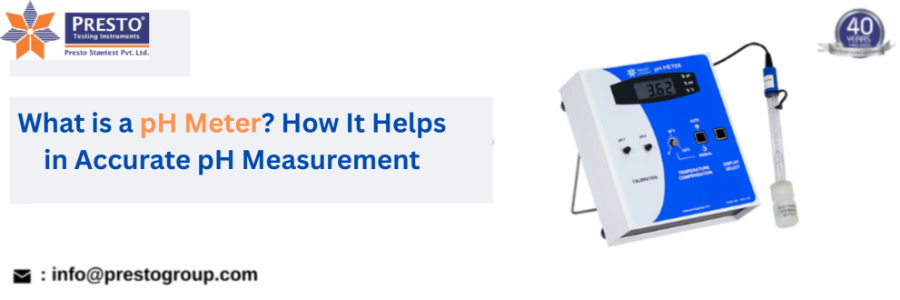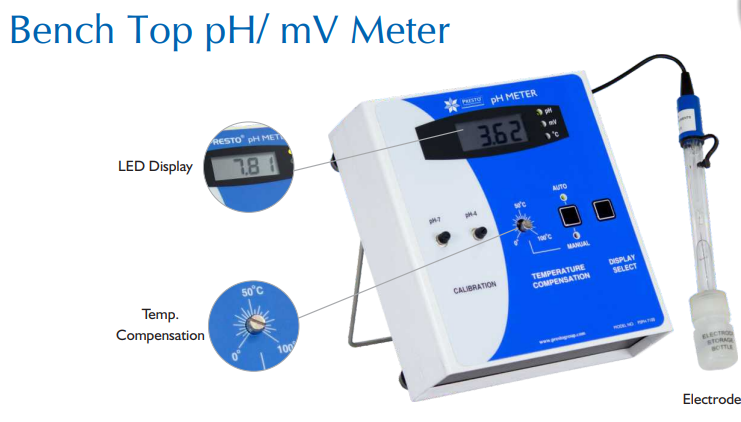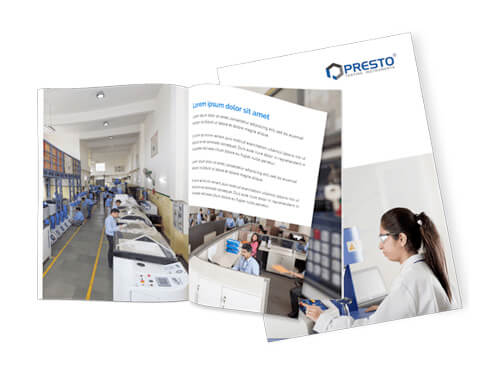What is a pH Meter? How It Helps in Accurate pH Measurement

Vishal Malhotra-Testing Instrument Expert
28-03-2025
The pH meter stands as a cornerstone in scientific exploration, bridging the gap between curiosity and precision. This remarkable instrument unveils the hidden nature of substances, revealing whether they lean toward acidity or alkalinity. Whether you're a chemist scrutinizing reactions, a farmer tending to soil, or a food scientist perfecting a recipe, the pH meter is an indispensable ally. In this detailed exploration, we’ll dissect its uses, scale, components, principles, pricing, and more—arming you with a thorough understanding of this vital tool. Let’s dive into the world of pH meters with clarity and rigor.
What is a pH Meter and How Does It Work?
A pH meter is a sophisticated device engineered to measure the hydrogen ion activity in a solution, expressed as pH—a logarithmic scale that quantifies acidity or basicity. Unlike rudimentary litmus paper, which offers a rough estimate, the pH meter delivers pinpoint accuracy, making it a staple in laboratories, industries, and even fieldwork. Its ability to translate subtle electrical signals into meaningful data has revolutionized how we analyze the chemical world.
.png)
pH Meter Uses: Where Does It Come in Handy?
The pH meter isn’t just a lab toy—it’s a workhorse in many areas of life. Here are some of its top uses:-
- Science and Research– In labs, scientists use pH meters to study chemicals, test reactions, and make sure experiments go as planned. It’s key for things like developing medicines or understanding how substances behave.
- Farming and Gardening – Farmers and gardeners check soil pH to see if it’s right for their crops or plants. Too acidic or too basic , and plants won’t grow well. The pH meter helps them adjust the soil to keep things thriving.
- Food and Drinks – Ever wonder why yogurt tastes tangy or why beer has a certain bite ? The food industry uses pH meters to control the taste, safety, and shelf life of products like cheese, wine, and canned goods.
- Water Quality– From swimming pools to drinking water, pH meters make sure the water is safe and balanced. Too acidic water can corrode pipes, while too basic water might not feel right.
- Health and Medicine– Doctors and researchers use pH meters to check things like blood or urine. A tiny change in pH can signal big health issues, so accuracy matters here.
Industry– Factories making detergents, cosmetics, or even paper rely on pH meters to get their products just right. It’s all about quality control.
In short, wherever liquids are involved, a pH meter can play a starring role. It’s a small tool with a big impact!
pH Meter Diagram: Visualizing the Setup
Picture this: a sleek probe dips into a beaker of liquid. The glass electrode, a thin-walled bulb, protrudes at the tip, encased in a protective sleeve alongside the reference electrode. Both connect via wires to a compact meter, its screen glowing with a pH value—say, 5.3 for orange juice. A temperature probe might peek out, linked to the meter for automatic adjustments. The diagram is simple yet elegant: probe meets solution, electrodes sense ions, meter translates voltage. This visual clarity demystifies the tool, showing how form follows function in pH measurement.

pH Meter Principle: The Science Behind the Signal
The pH meter operates on a potent principle: potentiometry. It measures the voltage difference between the glass and reference electrodes, a signal tied to hydronium ion activity. The glass electrode’s membrane, laced with silica and metal salts, interacts with hydronium ions outside, creating a potential proportional to their concentration. The reference electrode, unmoved by the solution, offers a baseline. This difference—roughly 59 millivolts per pH unit at room temperature—follows the Nernst equation, a thermodynamic law linking voltage to ion activity. The meter amplifies this tiny signal, converting it to pH via calibration against known buffers (e.g., pH 4 and 7). It’s a dance of electrons and ions, choreographed by physics, yielding chemical truth.
pH Meter Full Form: Unpacking the Term
The term 'pH' itself unravels as Potential of Hydrogen or Power of Hydrogen—both capture its essence as a measure of hydronium ion activity. pH meter, then, is shorthand for an instrument gauging this potential. No cryptic acronyms here--just a straightforward label for a tool that probes the potency of hydrogen in a solution. It is a name that nods to its purpose, rooted in chemistrys foundational language.
Why Choose Presto Stantest Pvt Ltd?
When it comes to buying a pH meter, the brand matters and Presto Stantest is a name you can trust. Here’s why they stand out:-
- Top-Notch Quality– Presto has over 40 years of experience making testing tools, including pH meters. They’ve even won a National Award for Quality from the Indian government, so you know their products are reliable.
- Accuracy You Can Count On– Their pH meters are built to give precise readings every time, whether you’re testing water, soil, or food. Big names like Amazon, Honda, and Maruti trust them for this reason.
- Great Support– Presto doesn’t just sell you a meter and leave you hanging. They offer fast service, training, and help to make sure you’re using it right.
- Affordable Options– From budget-friendly pocket meters to advanced lab models, Presto has something for everyone without breaking the bank.
- Global Reach– They export to over 34 countries, so their tools meet international standards—perfect if you want something world-class.
Choosing Presto means picking a company that’s all about quality, trust, and making your work easier. Whether you’re a beginner or a pro, they’ve got your back!
FAQs: Quick Answers to Core Questions
Q1. How Do You Use a pH Meter Properly?
Using a pH meter is easy! First, turn it on and dip the probe into a calibration solution (usually provided with the meter) to set it up—common ones are pH 4, 7, or 10. Rinse the probe with clean water, then dip it into the liquid you want to test. Wait a few seconds for the reading to settle on the display, and there’s your pH! Rinse the probe again after use to keep it clean.
Q2. Can a pH Meter Test Solids Like Soil or Food?
Not directly, but yes with a trick! For solids like soil or food, you mix them with a bit of distilled water to make a liquid solution. For example, mix one part soil with two parts water, stir it well, let it sit for a few minutes, then test the water with the pH meter. This gives you the pH of the solid in a roundabout way.
Q3. How Often Should You Calibrate a pH Meter?
It depends on how much you use it, but a good rule is to calibrate it before every important test or at least once a month if you use it often. Calibration keeps it accurate because the probe can drift over time. Always use fresh calibration solutions and follow the meter’s instructions for the best results.
Q4. What Happens If a pH Meter Gets Wet or Breaks?
Most pH meters are built to handle a little water—after all, they test liquids! But if the meter part (not just the probe) gets soaked, it might stop working, so dry it off fast. If the probe breaks (like the glass tip cracks), you’ll need to replace it. Good brands like Presto Stantest Pvt Ltd offer spare parts and support to fix these issues without buying a whole new meter.
Wrapping It Up: The pH Meter’s Enduring Impact
The pH meter is more than a gadget—it’s a gateway to understanding our world’s chemical pulse. From its intricate components to its wide-ranging uses, it embodies precision in a chaotic universe. Whether stabilizing a drug, nurturing a crop, or perfecting a brew, it delivers answers where guesswork once reigned. Its scale decodes extremes, its principle harnesses nature’s laws, and its price reflects a spectrum of needs. As we wield this tool, we don’t just measure pH—we unlock possibilities, one reading at a time. So next time you see that glowing number—be it 3 for lemon juice or 8 for soap—know it’s the pH meter at work, quietly shaping science and society.
Looking for the Best pH Meter Price?
At Presto Group, we offer high-quality pH meters at competitive prices. Contact us today to get the best pH meter price for your needs!
Call Now: +91 9210 903 903
Email Us: info@prestogroup.com
Recent News
- Paper & Packaging Testing Instruments
- Paint, Plating & Coating Testing Instruments
- Plastic & Polymer Testing Instruments
- Environmental Testing Chambers
- PET & Preform Testing Instruments
- Color Measuring Testing Instruments
- View Entire Range Instruments

Catalogue 2023
Get information about new product launches, research, innovation and endeavors at Presto.
download Free CopyNeed more information
Connect with us for your business enquiries. Generally we respond within one or two working days.
send enquiriesContact Us
Get a Quote
